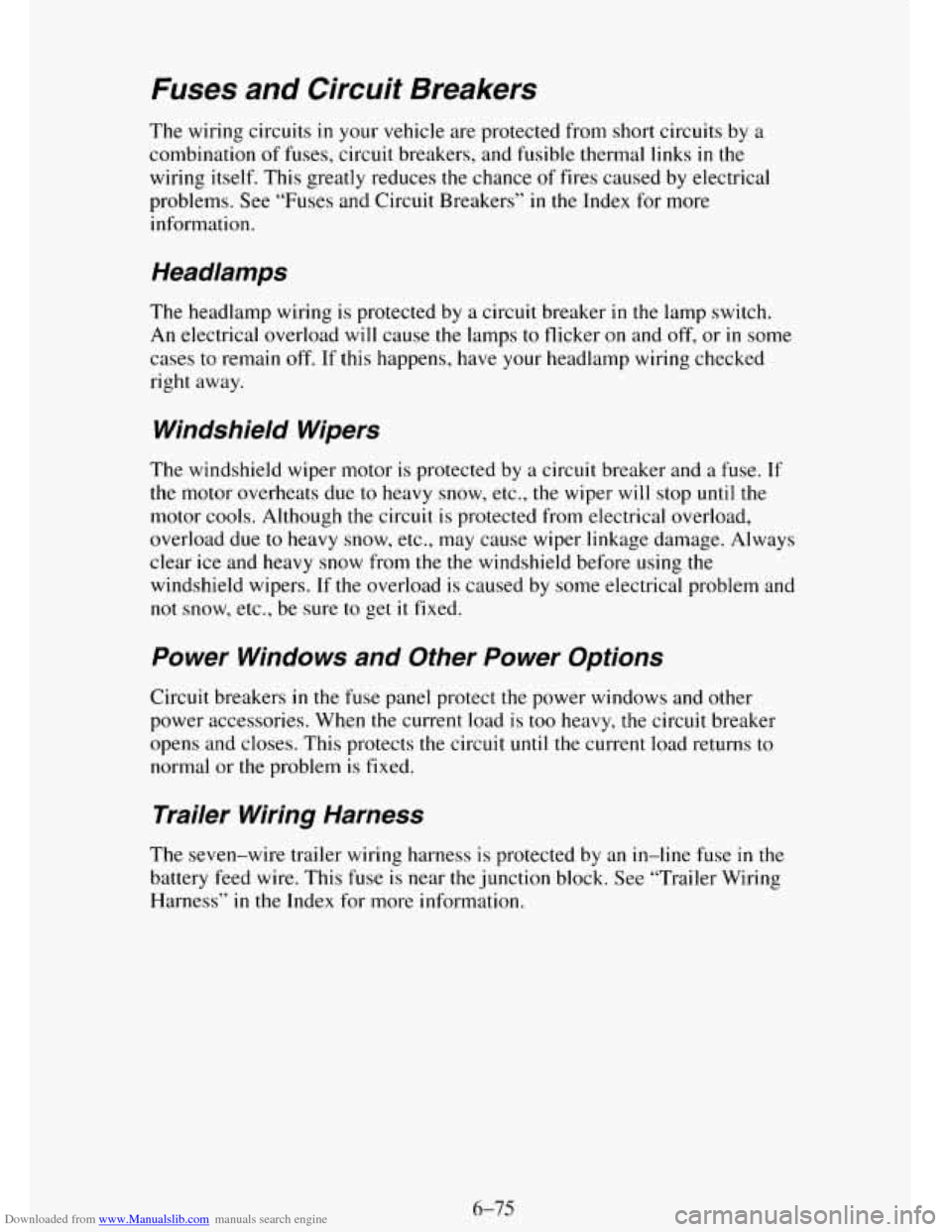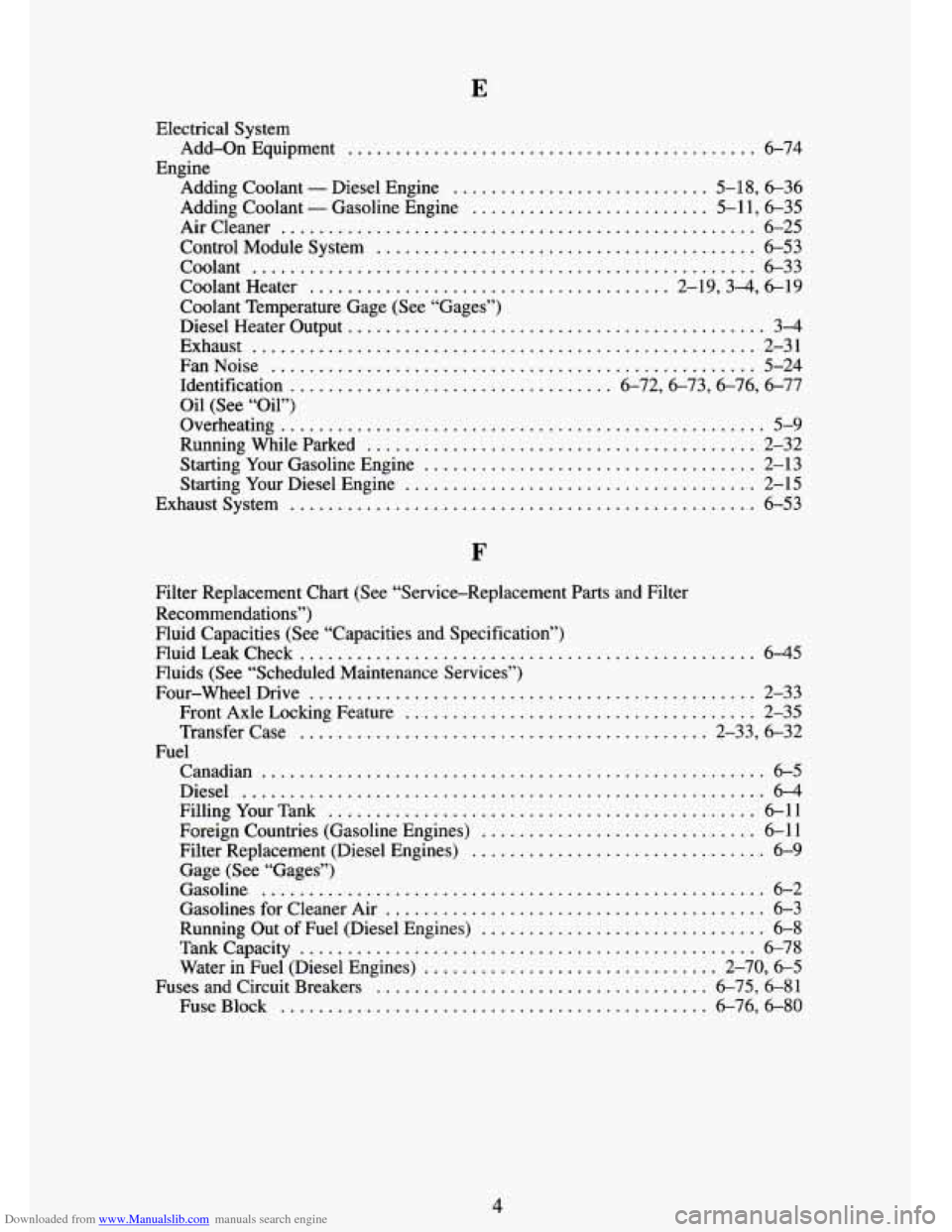Page 311 of 486
Downloaded from www.Manualslib.com manuals search engine Specification 6038-M.” Use GM Coolant Supplement (Sealer) with a
complete coolant flush and refill. If
you use this mixture, you don’t need to
add anything else.
NOTICE:
If you use an improper coolant mix, your engine could overheat
and be badly damaged. The repair cost wouldn’t be covered by
your warranty.
Too much water in the mix can freeze and crack
the engine, radiator, heater core and other parts.
Some conditions, such
as air trapped in the cooling system, can affect the
coolant level
in the radiator. Check the coolant level when the engine is cold
and follow the steps under “Adding Coolant”
for the proper way to add
coolant.
If you have to add coolant more than four times
a year, have your dealer
check
your cooling system.
I NOTICE:
If you use the proper coolant, you don’t have to add extra
inhibitors or additives which claim to improve the system. These
can be harmful.
6-34
Page 314 of 486
Downloaded from www.Manualslib.com manuals search engine To Add Coolant
If you need more coolant, add the proper mix crt the surge tunk, but only
when the engine
is cool. If the surge tank is empty, see “Engine
Overheating”
in the Index for the proper fill procedure.
A CAUTION:
You can be burned if you spill coolant on hot engine parts.
Coolant contains ethylene glycol, and
it will burn if the engine
parts are hot enough. Don’t spill coolant on
a hot engine.
When replacing the pressure
cap, make sure it is tight.
Radiator Pressure Cap - Gasoline Engine
The radiator pressure
cap
must be tightly
installed
with the
arrows on the cap
lined up with the
overflow tube
on the
radiator filler neck.
U
NOTICE:
Your radiator cap is a 15 psi (105 kPa) pressure-type cap and
must be tightly installed to prevent coolant
loss and possible
engine damage from overheating. Be sure the arrows on the cap
line up with the overflow tube on the radiator filler neck.
Page 315 of 486
Downloaded from www.Manualslib.com manuals search engine Surge Tank Pressure Cap - Diesel Engine
The surge tank
pressure cap must
be
tightly installed with
the arrows on the cap
lined up with the top
tube
of the coolant
surge tank.
NOTICE:
Your surge tank pressure cap is a unique 15 psi (105 kPa)
pressure-type cap for use with surge tank cooling systems only.
It must be tightly installed to prevent coolant
loss and possible
engine damage from overheating. Be sure the arrows on the cap
line up with the top tube of the coolant surge tank.
Thermostat
Engine coolant temperature is controlled by a thermostat in the engine
coolant system. The thermostat stops the flow
of coolant through the
radiator
until the coolant reaches a preset temperature.
When you replace your thermostat, an
AC@ thermostat is recommended.
6-38
Page 352 of 486

Downloaded from www.Manualslib.com manuals search engine Fuses and Circuit Breakers
The wiring circuits in your vehicle are protected from short circuits by a
combination of fuses, circuit breakers, and fusible thermal links
in the
wiring itself. This greatly reduces the chance
of fires caused by electrical
problems. See “Fuses and Circuit Breakers”
in the Index for more
information.
Headlamps
The headlamp wiring is protected by a circuit breaker in the lamp switch.
An electrical overload will cause
the lamps to flicker on and off, or in some
cases to remain off. If this happens, have your headlamp wiring checked
right away.
Windshield Wipers
The windshield wiper motor is protected by a circuit breaker and a fuse. If
the motor overheats due
to heavy snow, etc., the wiper will stop until the
motor cools. Although the circuit is protected from electrical overload,
overload due
to heavy snow, etc., may cause wiper linkage damage. Always
clear ice and heavy snow from the the windshield before using the
windshield wipers. If the overload
is caused by some electrical problem and
not snow, etc., be sure to get it fixed.
Power Windows and Other Power Options
Circuit breakers in the fuse panel protect the power windows and other
power accessories. When the current load is
too heavy, the circuit breaker
opens and closes. This protects the circuit
until the current load returns to
normal
or the problem is fixed.
Trailer Wiring Harness
The seven-wire trailer wiring harness is protected by an in-line fuse in the
battery feed wire. This fuse is near the junction block. See “Trailer Wiring
Harness”
in the Index for more information.
6-75
Page 477 of 486

Downloaded from www.Manualslib.com manuals search engine E
Eiectrical System
Engine Add-On
Equipment
........................................... 6-74
Adding Coolant
. Diesel Engine ........................... 5.18, 636
Adding Coolant
- Gasoline Engine .... , .................... 5-1 1’6-35 .
Air Cieaner
Coolant
.........................
Coolant Heater ...................
Coolant Temperature Gage (See “Gages‘
Diesel Heater Output
...............
.
......................
Control Module System ............
........................... 6-25
........................... 6-53
........................... 6-33
.................. 2-19.3-4. 6-19
1
............................ 3-4
Exhaust
..................................................... 2-31
FanNoise
................................................... 5-24
Identification .................................. 6-72.6-73.6-76. 6-77
Oil (See “Oil”)
Overheating
................................................... 5-9
RunningWhileParked ......................................... 2-32
Starting Your Gasoline Engine
................................... 2-13
Starting Your Diesel Engine
..................................... 2-15
Exhaust System
............................................... 6-53
F
Filter Replacement Chart (See “Service-Replacement Parts and Filter
Recommendations’’)
Fluid Capacities (See “Capacities and Specification”)
Fluid Leak Check
..................................... ........ 6-45
Fluids (See “Scheduled Maintenance Services”)
Four-WheelDrive
............................................... 2-33
Front Axle Locking Feature
..................................... 2-35
Transfer Case
........................................... 2-33. 6-32
Canadian
..................................................... 6-5
Diesel
....................................................... 6-4
Filling Your Tank ............................................. 6-11
Foreign Countries (Gasoline Engines)
............................. 6-11
Filter Replacement (Diesel Engines)
............................... 6-9
Gage (See “Gages”)
Gasoline
..................................................... 6-2
Gasolines for Cleaner Air
........................................ 6-3
Running Out of Fuel (Diesel Engines) .............................. 6-8
Tankcapacity ................................................ 6-78
Water in Fuel (Diesel Engines) ............................... 2-70. 6-5
Fuses and Circuit Breakers ................................... 6-75. 6-81
FuseBlock
............................................. 6-766-80
Fuel
4
Page:
< prev 1-8 9-16 17-24